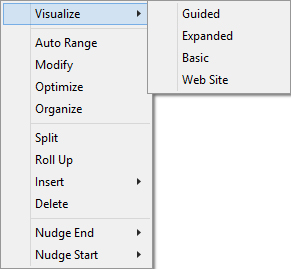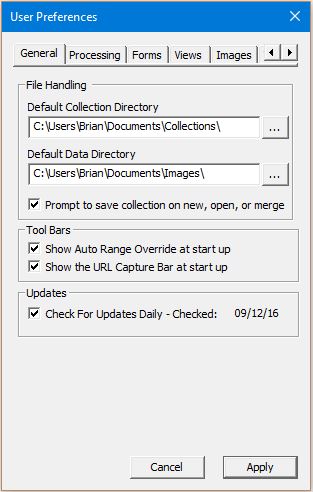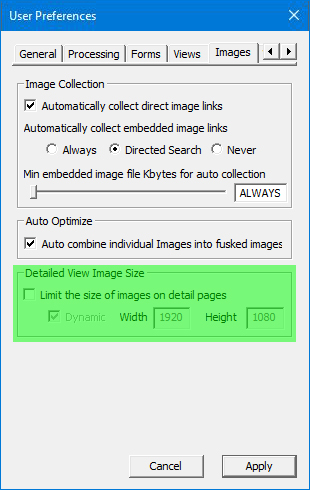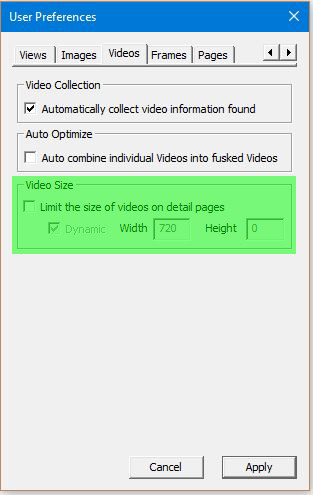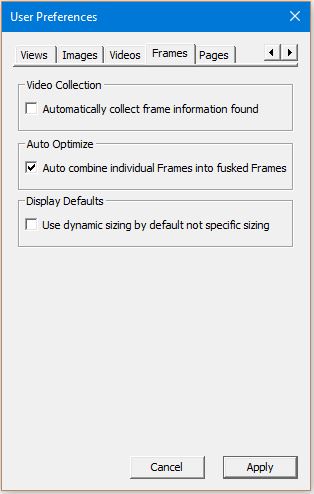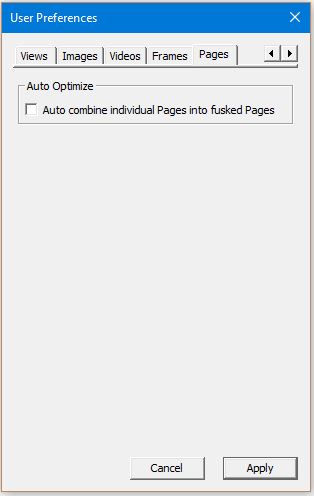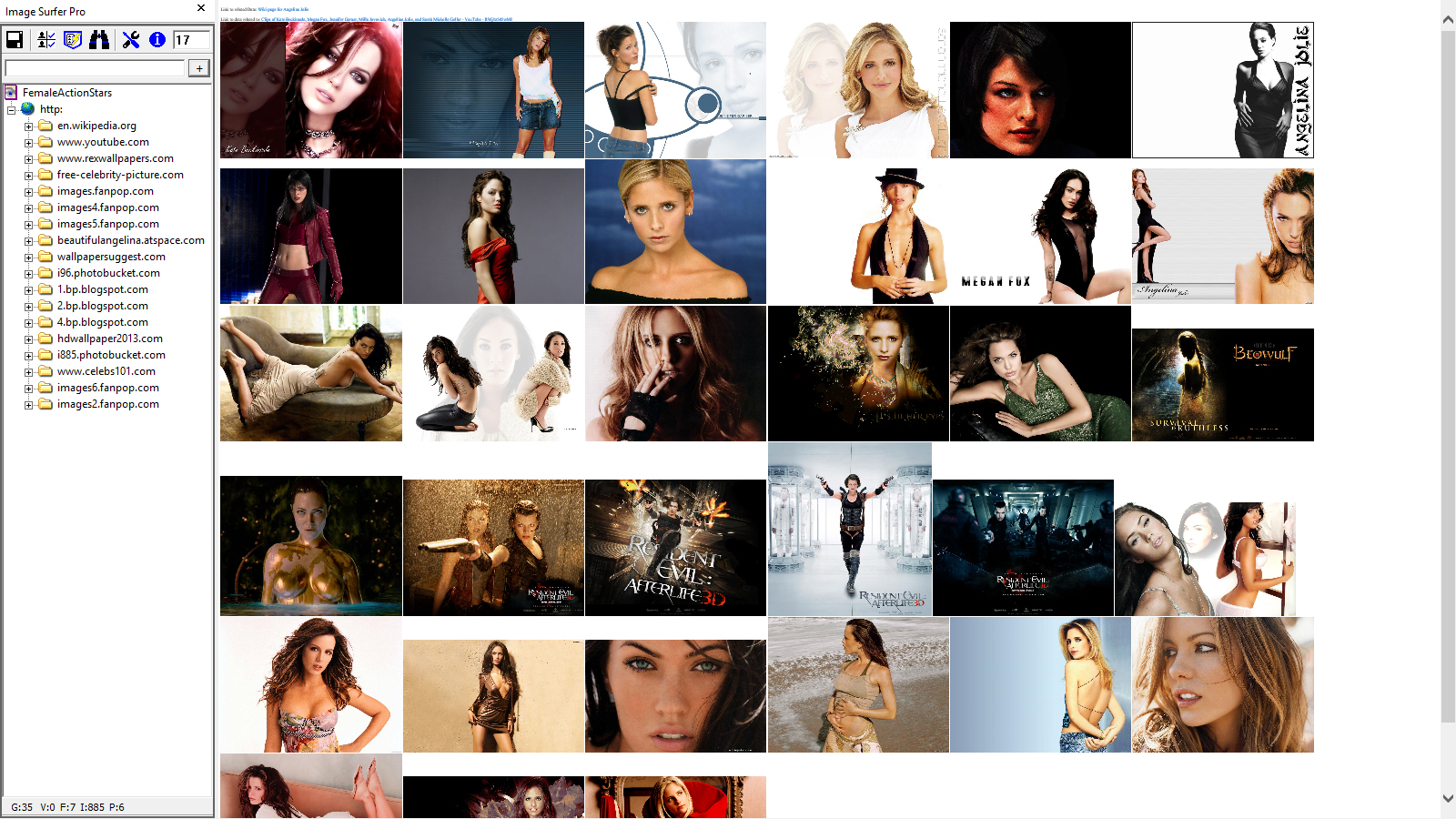View Types
There are four types of visualization available:- Basic:
Displays the first media file from each gallery below the current selected segment. Each type of media file is fully shown.
- Expanded:
Displays every media file referenced below the selected segment in a continuous sequence. Each type of media file is fully shown.
-
Webpage: Attempts to navigate the IE display window to the root directory of the tree
branch. This option is only available at the Root Directory or below.
-
Guided:
A Guided visualization generates a cover page of images and text labels each of which references an expanded view of the gallery the link was a part of. The expanded view of a gallery may contain more than one type of mdeia file, but the first media file from the gallery will be used to represent the gallery in the Guide Page. In the Guide Page the representation of the first media file is different based on the type of media file used:- Images: The image is limited in size by the {Guide Pages Image Size} user preferences.
- Videos: The poster image of the video is used and limited in size by the {Guide Pages Image Size} user preferences. If no poster file is present, a line of text describing the link is shown with the actual video file name as the reference link.
- Frames: The descriptinve text for the frame is used ad the link to the expanded gallery view. If no descriptive text is available, the media stream name itself is used.
- Pages: The descriptive text for the page is used as the link to the expanded gallery view. If no descriptive text is available, the page name itself is used.
Multi-Page Views
While the options on the Visualize Submenu override the user configurations of views based on segment type, they do not override the limits you have placed on the number of images per page generated.
When more than one page is required to display the media files from your fusker collection you will notice links placed at the top and bottom of the pages.

|
This link is placed at the top of each display page after the first page. It will take you back one Visualization page which displayed the previous set of media files in the visualization.\ |

|
This link will take you forward one Visualization page to the next set of media files in the visualization. This link is at the bottom of every page except the last page of the visualization. |
Image Surfer Pro Visualization Pages
Image Surfer Pro visualization pages are standard HTML pages built by Image Surfer Pro and stored in a temporary directory on your computer. The files are removed when the IE tab associated with the instance of Image Surfer Pro which created the files is closed. When more than one page is used to show the visualization the pages are linked via "relative" links. This means they can be copied to other locations or even published directly to the Internet.
Image Surfer Pro supports links to four types of media files: Images, Videos, Frames, and Pages. An Image Surfer Pro visualization page may display any combination of each of these media sources. The number of media files referenced by a particular visualization page may be configured in your User Preferences.
It is possible to create references in Image Surfer Pro which access media of the wrong type or to files which either do not exist or which reference content that can not be accessed via external webpages. When viewing a fusker collection these files represent missing file blocks and will display differently depending upon the media type Image Surfer Pro thought it was accessing.
Viewing ImagesImages are the cornerstone of early Image Surfer Pro development and arguably still the core media reference found in ISP Collection files. On Image Surfer Pro visualization pages, images are shown as images. Typically they are shown at full resolution but you may constrain the size of the images with your user preferences such that each image will be assured to fit within the IE display window. Each image is shown in a continuous manner without line breaks.
Each image is a clickable reference. Hovering over the image will bring up an information tag which tells you what the image links to. In some visualization types images on some pages will link to additional media from the related portion of the fusker collection. For example, images on "guide" pages link to "expanded" views of the gallery that contains the image. On other pages the image provides a direct link to the image file. Because of this, expanded and basic visualization pages can be treated as Free Hosted Galleries.
Viewing VideosBuilt-in browser and HTML support was introduced with the release of HTML5. Internet Explorer only supports MP4 video files referenced this way. We expect MP4 video to become the standard way video is presented on the web as it is already a growing portion of internet content. A poster image is typically associated with each video file.
On guide pages the poster image will be used to provide a link to the expanded gallery view which includes the video. In an expanded view, the video will be overlaid with the poster image. Hovering over the poster image with the mouse will reveal the controls available at the bottom of the video, such as play/pause, sound volume, full screen toggle, and a progress/tracking bar. By default Image Surfer Pro will display video files at the full resolution of the video without constraint. If you wish to constrain the initial size of videos such that they are sure to fit in the browser display window you may configure the size in the User Preferences.
Viewing FramesWith broadband internet access Tube Sites such as YouTube became a common surfing experience before HTML5 was available with direct support for MP4 files. Most of these sites use an IFrame interface to deliver video content. However, the IFrame tag in HTML is very flexible and essentially provides a generic window on the browser display that the hosting server controls and interacts through. This makes Frames Active Content and when you interact with these objects you are in essence directly interacting with the hosting server.
While MP4 is a growing segment of Internet traffic, there is no reason to expect IFrame data to go away. There are significant advantages to linking to block video data and entire content delivery networks have been built which specialize in delivering video content in this way.
In an expanded view the frame will be shown in a box below an Active Content warning. While a frame has no poster image, it is common for the server to provide a static image when the frame is not in "play mode" - so the box outline and warning are presented to assure you understand the frame is active content and not a direct video file. The size of the box and frame is determined by the sizing information contained in the frame segment.
Viewing PagesA page is meant to be the generic container for any content found which is not an Image, Video, or Frame. Image Surfer Pro utilizes the flexibility of the IFrame construct to provide a sub window in the IE display window where the content can be rendered by the hosting server. As was done with frames, pages are shown in a box with a warning that the page is active content. All pages are presented in a frame the size of the IE display window.
